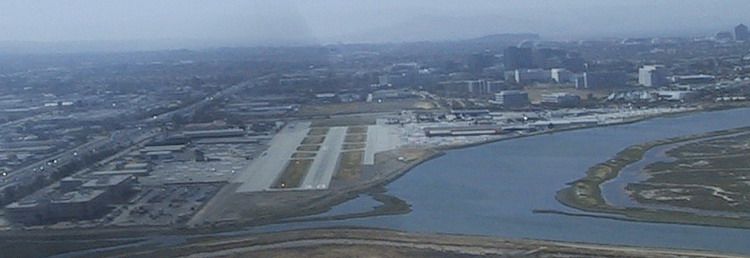Simplifying IFR Departure from San Carlos

The problem facing air traffic controllers (ATC) is that there isn't much room to squeeze departures out of SQL. Departing from runway 30, there are 3 choices, turn left, go straight, or turn right. Turning left is ruled out by rapidly rising terrain and noise sensitive areas. Going straight quickly runs into San Francisco International (SFO) airport, just 9 nautical miles upwind. That's not going to work! Turning right takes the departure over the bay, but still right under the arrival path for SFO. Those jets are too low to have legal IFR separation northwest of SQL, and even directly overhead of SQL. However, at the southeast end of SQL (near the 30 numbers), the jets are far enough out (and thus high engough up) that the airliners trundling down final and light planes flying under them can be worked together.
ATC's solution is to have the SQL departures stay VFR until they are far enough out from under SFO's final to fit into the IFR system.
First, the easy case. If you're lucky enough to be departing from runway 12, then life is good. You'll be able to be fully IFR from the beginning. You're taking off heading away from SFO and will be in the clear (relatively speaking) all the time. The usual clearance is "… fly runway heading, radar vectors [first navaid], … climb and maintain 2,000', expect [final altitude] after 5 minutes…" That's pretty easy IFR.
Departing 30, though, you're likely to get a clearance something like this:
"…fly runway heading to the diamond shaped waterway, then turn right heading 120° within 2 miles of the airport, radar vectors [first navaid], … maintain VFR at or below 1,100’ until crossing the Oakland 165 degree radial, then climb and maintain 2,000’, expect [final altitude] after 5 minutes"
To fly this can be a real workload enhancer. Here are some ways to make it easier:
If you fly Visual Flight Rules (VFR) from SQL, you may notice that the IFR departure is exactly the same as the regular VFR (noise abatement) downwind departure until you get to that OAK 165° radial. In fact, it's almost like they're saying, “just depart VFR downwind, and then you can start your IFR from there.”
Even when you set it up on the ground, it can be tough to get that OAK 165° radial identified while you're departing, turning, climbing, making sure you don't blow through 1,100', talking to ATC, and wishing your instructor would stop harping at you for forgetting to start your timer. So here's the big trick: you cross the OAK 165° radial on downwind abeam the 30 runway numbers. Since you have to be VFR until then anyway, you don't even need to tune the OAK VOR to comply with the clearance. Just do a downwind departure staying away from the clouds below 1,100' until you're abeam the 30 numbers.
Set your navigation equipment for your first navaid (not the OAK 165° radial), and your heading bug to 120° (not runway heading). Again, since you're VFR until you're on heading 120° and past the runway numbers, that's the earliest you'll really need electronic navigation and the heading bug anyway, unless you are a very eager autoppilot user!
What if you can't maintain VFR at or below 1,100'? The good news is that usually if the clouds are low enough to prevent this, either the wind is strongly favoring runway 12 anyway (a front is passing through) or the wind is calm enough to use 12 (low clouds/mist/fog typical of winter high pressure). The summer stratus rarely gets low enough to prevent using the 30 departure, though you may have to fly the downwind leg lower than usual to maintain VFR cloud clearance. Keep in mind that even if the ATIS is advertising “runway 30 in use”, you can still request 12 if you believe the conditions warrant it. If the weather is low enough that you can't maintain VFR until downwind, I doubt you'll face any conflicting traffic, to the Tower will be happy to accommodate you.
Sometimes, when things are really hopping at SFO, you can wait a long time for IFR release. If the clouds are high (say, 3,500' bases), you can sometimes expedite your departure by offering a VFR climb. For that to work the SQL controller has to be willing (i.e, not busy) enough to call up approach and ask on your behalf, and the approach controller has to be fairly savvy. But if it works, it can shave a lot of time off your departure.
For instance:
SQL: “approach advises a 15 minute delay for traffic.”
You: “Roger. Could you please ask approach if a VFR climb to 3,000' towards Woodside would help move things along?”
SQL: “Standby” … “Approach can take you now if you accept a VFR climb to 2,500'”
You: “We can do that”
SQL: “Maintain VFR during your climb to 2,500', right downwind departure approved, cleared for takeoff”
You: “VFR below 2,500, cleared for takeoff, thanks for the help!”
This won't work in every case, and you should keep in mind (and in your attitude) that the controllers involved are doing you at least a little bit of a favor, so let them know you appreciate it.
I hope this helps smooth your flights out of SQL. As always, please be considerate of the noise-sensitive neighbors when using SQL, and have fun!
